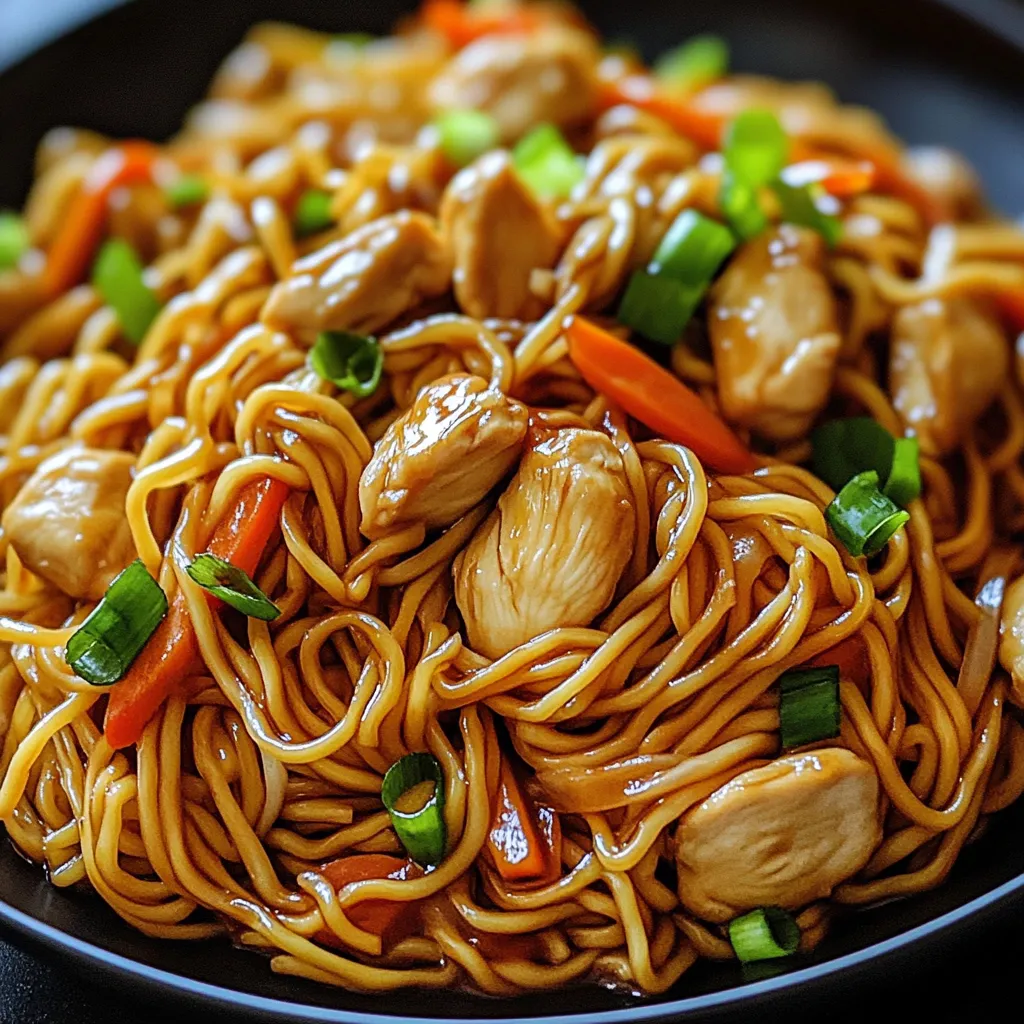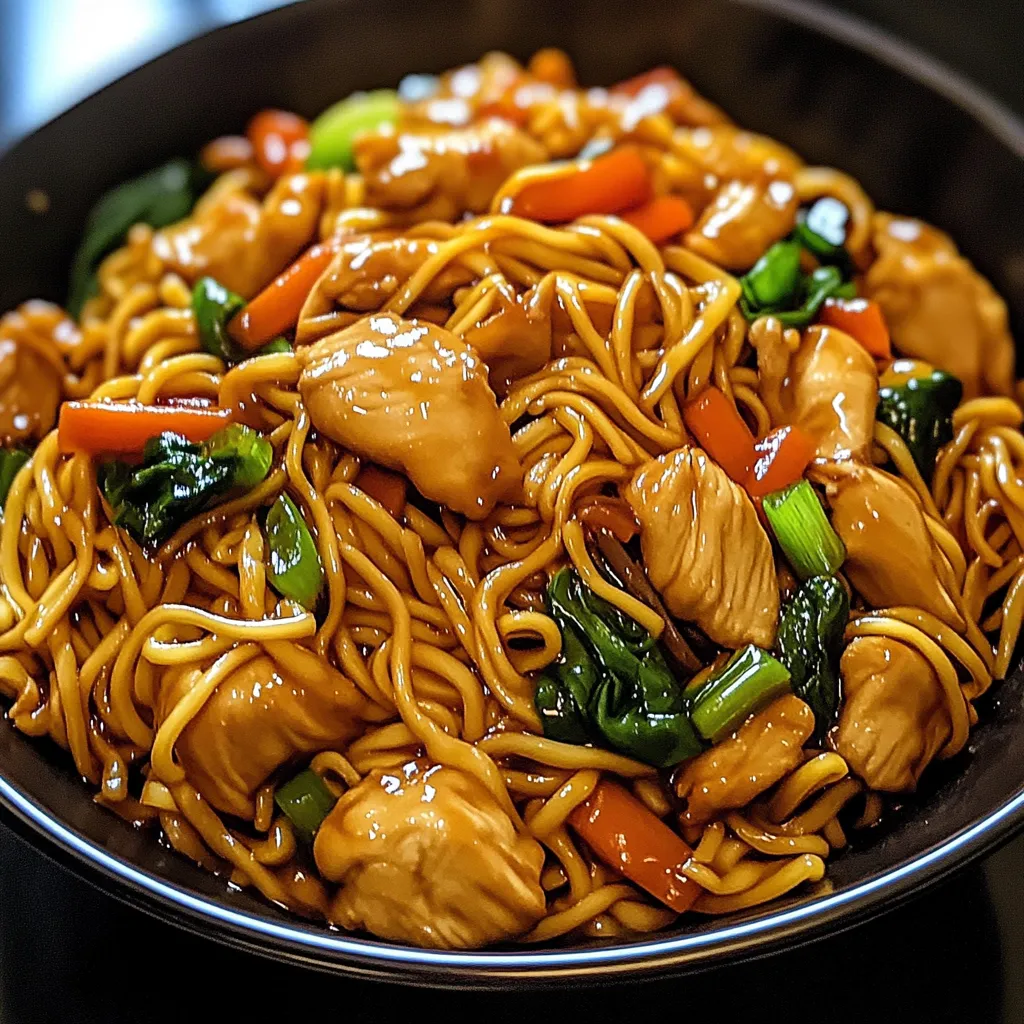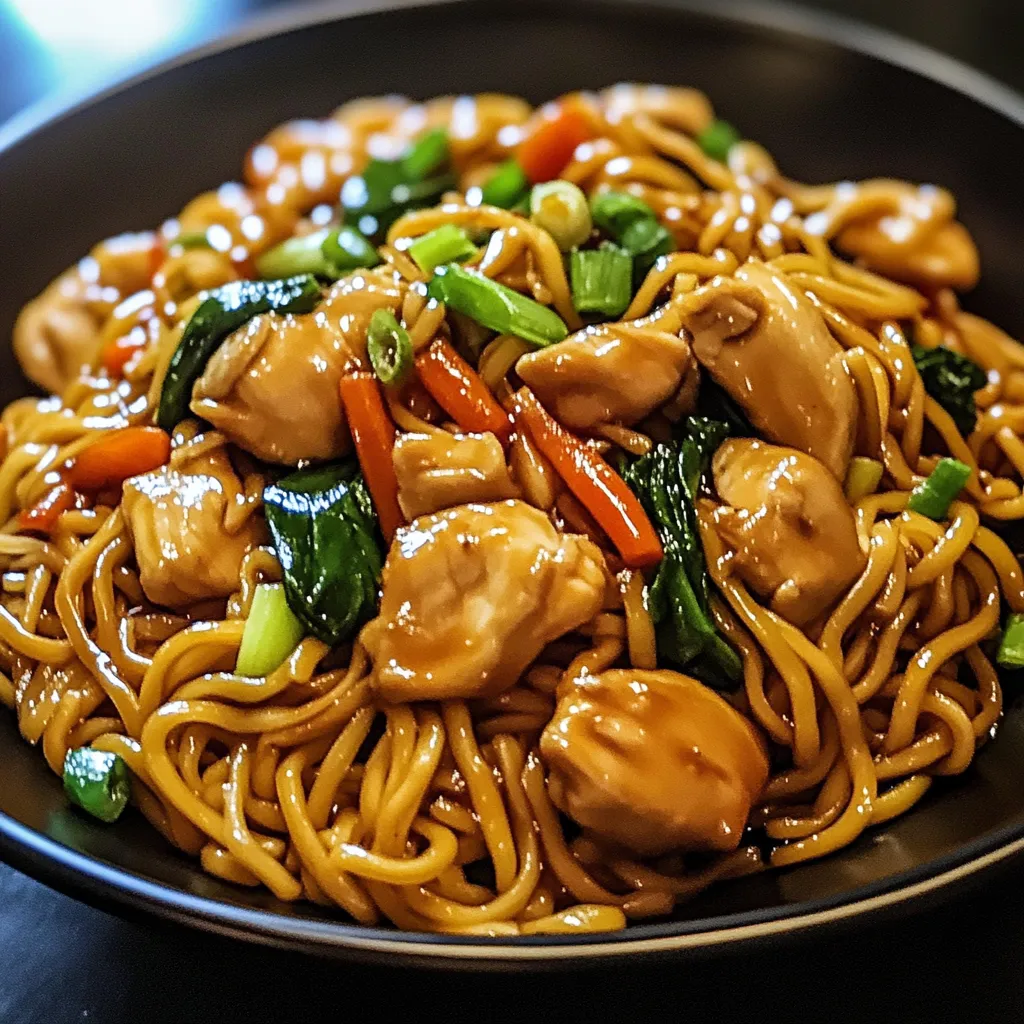 Save
Save
Silky noodles twirl around tender chicken strips and crisp vegetables, all bathed in a savory, glossy sauce that delivers the perfect balance of salty, sweet, and umami flavors in every mouthful. This homemade chicken chow mein brings authentic Chinese restaurant taste to your kitchen with ingredients easily found in most grocery stores. The distinctive combination of soy sauce, oyster sauce, and sesame oil creates depth of flavor that transforms simple ingredients into an extraordinary meal that satisfies those takeout cravings without leaving home.
I discovered this recipe after years of disappointing takeout experiences in my small town where authentic Chinese food was hard to find. After countless attempts to recreate that perfect balance of flavors, this version finally captured the essence of what makes chow mein so irresistible. When I served it to my skeptical husband who typically reserves praise for restaurant meals, he immediately requested I add it to our regular dinner rotation. Even my children, normally suspicious of anything with visible vegetables, clean their plates every time I make this dish.
The Perfect Sauce Ingredients
- Low-Sodium Soy Sauce: Forms the savory foundation of the sauce—choose low-sodium varieties to control the salt level while still enjoying rich umami flavor
- Oyster Sauce: Provides distinctive depth and complexity impossible to achieve with other ingredients—this thick, concentrated sauce delivers authentic Chinese restaurant flavor
- Sesame Oil: Just a small amount adds aromatic, nutty notes that elevate the entire dish—always add at the end of cooking to preserve its delicate flavor profile
- Rice Vinegar: Balances richness with gentle acidity for perfect flavor harmony—don't substitute with other vinegars as rice vinegar has unique subtle sweetness
- Brown Sugar: Contributes mild caramel notes that round out the savory elements—dark brown sugar provides deeper flavor than light brown or white sugar
- Chicken Broth: Creates volume and melds flavors while adding subtle richness—homemade broth brings additional depth, but store-bought works perfectly fine
- Cornstarch: Transforms the sauce from watery to silky and clingy—mix with cool liquid first to prevent clumping
- Fresh Garlic and Ginger: Aromatic foundation that infuses the entire dish—mince them extremely fine for even distribution without overwhelming bites
Noodle Perfection
- Prepare The Sauce:
- Whisk together three tablespoons soy sauce, two tablespoons oyster sauce, one teaspoon sesame oil, one teaspoon rice vinegar, one tablespoon brown sugar, half cup chicken broth, and one tablespoon cornstarch in a small bowl until completely smooth with no lumps. This well-combined mixture will thicken beautifully when added to the hot pan.
- Cook The Protein:
- Slice one pound boneless chicken breast against the grain into thin strips for maximum tenderness. Heat one tablespoon vegetable oil in a large wok or skillet over medium-high heat until shimmering. Add chicken in a single layer without overcrowding, working in batches if necessary, and cook undisturbed for two minutes to develop golden edges before stirring.
- Enhance With Aromatics:
- Remove cooked chicken to a clean plate and add another tablespoon oil to the same pan. Add three minced garlic cloves and one tablespoon freshly grated ginger, stirring constantly for thirty seconds until intensely fragrant but not browned. This brief cooking releases essential oils without burning these delicate ingredients.
- Layer The Vegetables:
- Add one thinly sliced onion, one julienned bell pepper, and one cup shredded cabbage to the aromatic oil. Maintain high heat while stirring frequently for about three minutes until vegetables begin to soften but still retain some crispness. The cabbage will significantly reduce in volume as it cooks.
- Prepare The Noodles:
- While vegetables cook, prepare eight ounces of chow mein noodles according to package directions, being careful not to overcook. Rinse briefly under cool water to stop cooking and prevent sticking if not using immediately. Fresh noodles require minimal cooking while dried varieties need more time.
- Combine All Elements:
- Return cooked chicken to the pan with vegetables. Pour the prepared sauce around the edges of the hot pan rather than directly on ingredients. Bring to a simmer and cook for about two minutes until sauce thickens and turns glossy while coating everything evenly.
- Incorporate Noodles:
- Add drained noodles to the pan, using tongs to gently lift and turn everything together until noodles are completely coated with sauce and heated through. This should take about one minute—overcooking at this stage will make noodles soggy.
- Final Fresh Touch:
- Turn off heat and sprinkle with thinly sliced green onions, tossing once more to incorporate. Allow dish to rest one minute before serving, which lets flavors meld and sauce reach optimal consistency that clings perfectly to each strand of noodle.
 Save
Save
My grandmother always said the mark of a good chow mein was the 'wok hei'—that distinctive flavor that comes only from cooking quickly over high heat. I remember standing beside her in the kitchen, watching in amazement as she tossed ingredients with practiced precision. While my home stovetop can't quite match her traditional wok over flame, this recipe comes remarkably close to capturing that elusive restaurant quality. The first time I added oyster sauce to my homemade version was a revelation—that single ingredient transformed my adequate stir-fry into something truly special that transported me back to her tiny kitchen filled with incredible aromas.
Serving Inspirations
Transform this versatile dish into a complete meal experience with thoughtful accompaniments and presentation. Create an authentic Chinese restaurant atmosphere by serving family-style in a large decorative bowl with chopsticks and small side plates for individual portions. Balance the meal with a simple cucumber salad dressed with rice vinegar and sesame seeds for refreshing contrast to the rich noodles. For a more substantial feast, pair with crispy vegetable spring rolls or steamed dumplings that complement without competing with the chow mein flavors. Consider offering condiment options like chili oil, sriracha, or additional soy sauce, allowing everyone to customize their serving according to personal taste preferences.
Delicious Variations
Adapt this recipe to suit different tastes, dietary needs, and whatever ingredients you have available. Seafood lovers can substitute shrimp for chicken, adding it later in the cooking process and just until pink to prevent overcooking. Vegetarian version works beautifully using firm tofu cubes pressed between paper towels to remove excess moisture before marinating in a tablespoon of soy sauce. For a heartier texture variation, use thicker lo mein noodles instead of thinner chow mein varieties, adjusting cooking time accordingly. Spice enthusiasts can add dried red chili flakes when cooking aromatics or incorporate a tablespoon of chili garlic sauce into the sauce mixture for pleasant heat throughout.
Proper Storage
Extend the enjoyment of this flavorful dish with proper storage techniques that maintain quality and taste. Transfer completely cooled leftovers to airtight containers within one hour of cooking to preserve freshness and prevent bacterial growth. Refrigerate promptly for up to three days, keeping noodles separate from any extra sauce to prevent sogginess. When reheating, sprinkle one tablespoon of water over noodles before microwaving covered for one to two minutes, stirring halfway through. For superior texture, reheat in a hot skillet with a touch of oil, stirring constantly until just heated through. For meal prep purposes, prepare all components separately and store refrigerated, then combine just before serving for the freshest possible flavor and texture.
 Save
Save
Creating authentic Chinese flavors at home has become one of my cooking passions, and this chicken chow mein recipe represents years of trial and error to achieve that perfect balance. What makes this dish special is not any single ingredient but rather the harmonious combination of flavors and textures—tender chicken, crisp vegetables, chewy noodles, and that glossy, savory sauce that brings everything together. This has become my signature dish that friends and family request whenever they visit, and teaching others how to make it has been a joy. The smile of recognition when someone tastes truly authentic chow mein makes all the experimentation worthwhile.
Common Questions About Cooking
- → What's the difference between chow mein and lo mein?
- Chow mein uses parboiled noodles that are stir-fried until slightly crispy, while lo mein noodles are fully cooked and simply tossed with the ingredients and sauce, resulting in a softer texture.
- → Can I make this dish gluten-free?
- Yes! Use rice noodles or gluten-free chow mein noodles, and substitute regular soy sauce with tamari or coconut aminos. Also check that your oyster and hoisin sauces are gluten-free versions.
- → What can I use if I don't have oyster sauce?
- You can substitute oyster sauce with additional hoisin sauce, or a mixture of soy sauce, sugar, and a touch of Worcestershire sauce. For a vegetarian option, try mushroom-based vegetarian oyster sauce.
- → How do I prevent the noodles from sticking together?
- Rinse the noodles in cold water immediately after cooking, then toss with a small amount of oil if you're not adding them to the stir-fry right away. Don't overcook them - they'll continue cooking when added to the stir-fry.
- → Can I prepare any parts of this recipe ahead of time?
- Yes! The sauce can be made up to 3 days ahead and stored in the refrigerator. You can also prep all vegetables and slice the chicken a day in advance to make cooking even quicker.
- → What other vegetables work well in chow mein?
- Bell peppers, snap peas, mushrooms, water chestnuts, baby corn, and broccoli all work wonderfully in chow mein. Feel free to customize with whatever vegetables you have on hand.
